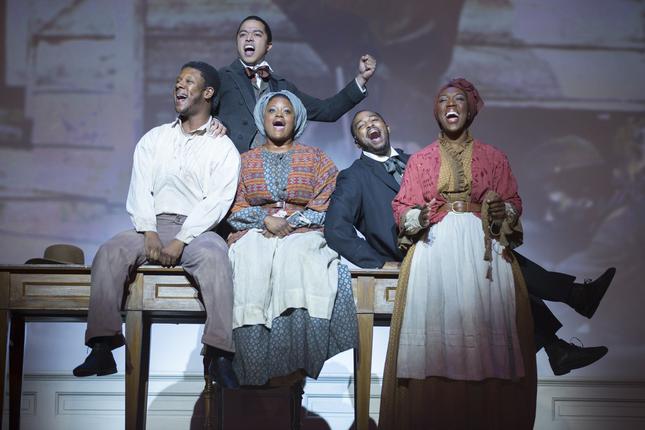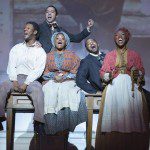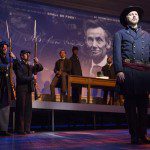‘Freedom’s Song’ at Ford’s Theatre
By • April 13, 2015 0 1103

As the smartly brief but epic musical “Freedom’s Song: Abraham Lincoln and the Civil War” moves to its inevitable end at Ford’s Theatre, a shot rings out, loud, sudden and startling – all the more surprising and emotionally powerful because it’s familiar, because we’ve been expecting it.
The sound comes from the hallowed presidential box. We know this because we know exactly where we are, if not in time, then certainly in history.
The moment is a punch, a kind of climax to the production at hand. It sparks a keen awareness of being here, in this theatre, and also that we are in the midst of the commemoration of the assassination of Abraham Lincoln on April 14, 1865. He and his wife Mary Todd Lincoln were at Ford’s to watch a comedy, “Our American Cousin,” starring the noted actress Laura Keene.
That box to the side of the balcony is always there and always has been. In many ways, it’s the reason for the theatre’s existence, and nothing accentuates that fact more than an anniversary of the assassination.
The same day that “Freedom’s Song” opened, a press preview was held across the street at 514 10th St. NW, the theatre’s Center For Education and Leadership, for the exhibition “Silent Witnesses: Artifacts of the Lincoln Assassination.” The small space is filled with artifacts: the overcoat Lincoln was wearing, the oh-so-small derringer used to kill him, Mary Todd’s black velvet coat and fragments of her bloodied dress, letters, the president’s top hat and so on. It is an intimate space and show, but hugely resonant with the “Freedom’s Song” production.
Both events are part of “Ford’s 150: Remembering the Lincoln Assassination,” a season-long series of events that began with the play “The Widow Lincoln.” A highlight of the schedule is “The Lincoln Tribute,” a round-the-clock event on April 14-15, with talks, a one-act play, a panel discussion and living-history presentations on 10th Street about the two days surrounding the assassination, including Lincoln’s death at 7:22 a.m. at the Petersen House.
The proximity of the “Silent Witnesses” exhibition to the “Freedom’s Song” production creates a kind of reciprocal poignancy. Knowing what Lincoln carried in his pocket – two pairs of spectacles and a lens polisher, a watch fob, a pocket knife, a wallet containing a five-dollar Confederate note, a linen handkerchief and, apparently, newspaper clips that included articles critical of him – adds something to his words as spoken by members of the cast of “Freedom’s Song,” the human, earthy, prosaic stuff of a great man.
It is not the first time that the presence of the box – the loca sancta, if you will – becomes important at a Ford’s production. Recent plays about Lincoln, a previous offering of the musical “The Civil War,” which forms the basis for “Freedom’s Song,” “The Rivalry,” “The Widow Lincoln,” “The Stars Hung in Black” and so on, resonate in ways that they could not do anywhere else. These days, visitors take selfies with the box in the background before the plays begin.
“Freedom’s Song” is a series of songs as vignettes, bringing us through the Civil War as if we are riding in a musical carriage. The difference is that the words – speeches, musings, outtakes, stories – of Lincoln have been added, creating another kind of effect altogether. They are spoken by members of the cast, a group of young performers playing Union and Confederate soldiers, slaves, mothers, wives and the like as the war rolls over them in ever larger waves.
Lincoln speaks through the cast: the Gettysburg address entire, words of emancipation, a droll story of the kind Lincoln loved to tell, words on the end of the war and so on, punctuating the proceedings with his singular eloquence as we move through them.
What director Jeff Calhoun and designers Tobin Ost (sets), Wade Laboissonniere (costumes) and Michael Gilliam (lighting) have done is to create an ambiance of the Civil War. What composer Frank Wildhorn and writers Gregory Boyd and Jack Murphy have done is to overlay the narrative with a march of Americana music, songs that demand tears, emotional responses, soaring hearts and reminders of the past – and how it might have been lived and lived in.
The songs are the essence of historical pop, staged like living and lively frescoes. Slaves huddled under a table sing powerfully about “The Peculiar Institution” and its horrors, a wife sings beautifully about missing her young farmer husband, Confederates soar with “The Last Waltz of Dixie” and carouse around “The Old Gray Coat” and a fugitive slave powerfully lashes out in “Father, How Long?”
American pop music plays on emotions – it’s what makes the Great American Songbook great, after all. The cast performs it more than well, especially Carolyn Agan as the wife, Kevin McAllister as the Fugitive, Nova Payton as the Storyteller and Gregory Maheu as the Union Private, an appealing young soul who practically has a Dead Man Walking sign on his back.
The music doesn’t match the eloquence of Lincoln’s words; the words have the effect of elevating the songs to a higher level.
The shot, when it comes, carrying with it echoes from the exhibition, is a jolt. You can hear people stop breathing for a moment. That, too, is part of the music in “Freedom’s Song” – that small gun doing so much damage, bringing us here to this place.
“Freedom’s Song” runs through May 20 and “Silent Witnesses” through May 25.
- Kevin McAllister, Joban Parker-Namdar, Nova Y. Payton, Rayshun LaMarr Purefor and Ashley D. Buster in “Freedom’s Song.”




